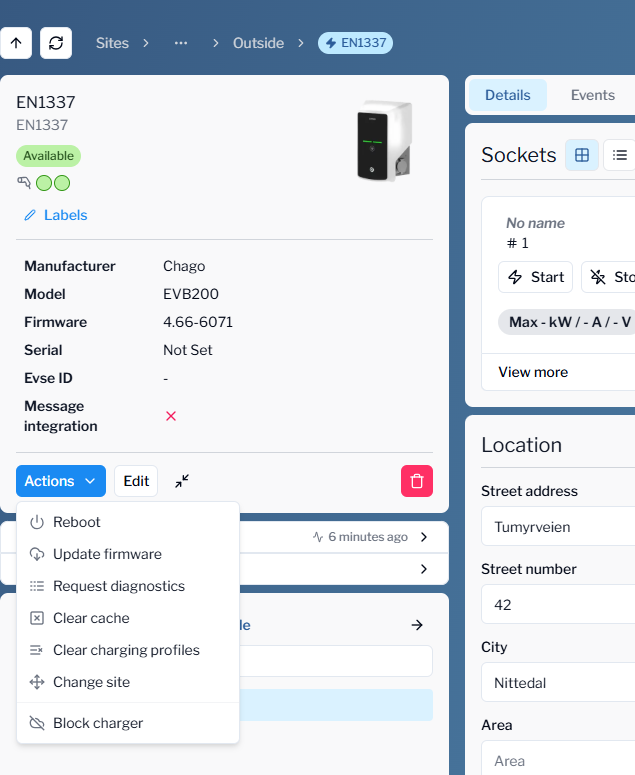Charger actions
The eMabler platform provides powerful remote tools for charger management and troubleshooting. Through the Actions menu, operators can perform key maintenance, configuration, and administrative tasks, improving uptime, operational control, and service responsiveness. These remote actions reduce the need for on-site visits, helping CPOs lower costs and resolve EV charger issues faster.
1. Reboot Charger
Purpose:
Resolve operational issues, apply new configurations, or complete firmware updates.
Access Path:Charger > Actions > Reboot

Reboot Types:
Soft Reboot: Graceful restart without interrupting power flow.
Hard Reboot: Powers down the charger completely before restarting.
Use Soft in most cases. Use Hard only if specified by the manufacturer or if the charger is unresponsive.
2. Update Firmware
Purpose:
Install new software releases to enhance performance, compatibility, and security.
Steps:
Host the firmware file on an accessible FTP/HTTP(S) server.
Go to
Actions > Update Firmware.Enter the full firmware URL, including credentials if needed:
ftp://user:pass@server.com/firmware.binClick Update Firmware to send the request.
Post-update reboot may be required depending on charger type.
Monitor progress:
Check the Last message section for update status feedback.
3. Request Diagnostics
Purpose:
Request diagnostic logs from the charger to support remote troubleshooting.
Requirements:
An FTP URL where the charger can upload the diagnostics ZIP.
Steps:
Go to
Actions > Request Diagnostics.Input the FTP address with credentials if needed.
Confirm to trigger diagnostics upload.
Success Example (Last message):
// Example message:
[
2,
"35123123-asd23-243x-ba12-0141fc",
"DiagnosticsStatusNotification",
{ "status": "Uploaded" }
]Click here to get more information on how to retrieve diagnostic information
4. Clear Cache
Purpose:
Flush authorization and session caches stored on the charger.
When to use:
Delays or failures in user authorization
Suspected outdated session data
Access Path:
Actions > Clear Cache
No reboot required afterward.
5. Clear Charging Profiles
Purpose:
Remove charger-side Dynamic Load Management (DLM) schedules or limits.
Steps:
Go to
Actions > Clear Charging Profiles.Check the Confirm box and click Clear Charging Profiles.
Manually reboot the charger afterward to fully reset power rules.
Until rebooted, power constraints may not be enforced.
6. Change Site
Purpose:
Move a charger to a different site within your operator or customer organization.
Steps:
Go to
Actions > Change Site.Select the target site from the searchable dropdown.
Click Save to reassign the charger.
This is useful for reorganizing installations, migrations, or fixing misassignments.
Summary Table
Action | Purpose | Input Required | Reboot Needed |
|---|---|---|---|
Reboot Charger | Resolve errors / finalize updates | Select reboot type | Optional |
Update Firmware | Apply firmware updates | URL to firmware file | Sometimes |
Request Diagnostics | Retrieve charger logs | FTP upload URL | No |
Clear Cache | Flush authorization/session data | None | No |
Clear Charging Profiles | Remove DLM/scheduling constraints | Confirmation | Yes |
Change Site | Move charger to another site | Site selection | No |
